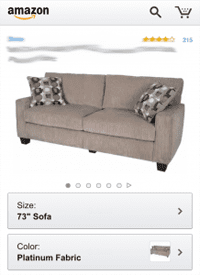
Retail Posts
The retail landscape is changing very quickly these days. Stay on top of retail news by reading the Factoring 101 Blog.
Jump to a Post
The Changing Furniture Landscape
Over the past decade we have slowly been watching the retail landscape transform from traditional brick and mortar stores to online shopping. However, as a result of the COVID-19 pandemic, 2020 not only experienced the greatest shift towards online shopping, but for the first time direct-to-consumer e-commerce sites have taken the largest share of the furniture market. After leading in growth rate for the past seven years, these online retailers grew by an incredible 47% in 2020. According to Furniture Today, online retailers now have a 20.8% market share of the furniture market, where traditional furniture stores only have a 20.5% market share. After that, lifestyle furniture stores have a 14.3% share of the market, discount department stores have a 13.4% share, manufacturer-branded furniture stores have a 11.5% share, bedding specialists have a 8.7% share, warehouse clubs have a 7.4% share, and finally rental centers only have a 3.4% share. This shifting marketplace can be seen by taking a look at the top 10 furniture retailers for 2020.
Leading the change in direct-to-consumer was Wayfair, which supplanted Ashley HomeStore as the number one furniture store in terms of total sales, ending an 11-year streak of Ashley holding the top spot. However, Wayfair didn’t just sneak past Ashley but rather skyrocketed past them. Wayfair’s furniture sales were over $6.66 billion in 2020, a 54% increase over 2019’s $4.34 billion in sales. Ashley on the other hand was much more stable with sales growing from $4.75 billion in 2019 to $4.8 billion in 2020, while adding 30 more stores to their retail footprint.
The other huge increase was made by Amazon who knocked Walmart out of the number 3 spot for total furniture sales. Amazon experienced 38% growth in furniture as sales increased from $3.16 billion in 2019 to $4.37 billion in 2020. Walmart, who in addition to their large retail footprint also sells online, only experience 9% growth in furniture as sales increased from $3.19 billion in 2019 to $3.48 billion in 2020. Of course, unlike Wayfair and Ashley where furniture makes up the majority of their total sales volume (56% for Wayfair and 95% for Ashley), furniture makes up a trivial percentage of both Amazon and Walmart’s total sales. Furniture accounted for only a little over 1% of Amazon’s total sales, and for less than 1% of Walmart’s total sales.
Remaining in the number 5 spot was Mattress Firm, the only bedding specialists to make it into the top 10. Mattress Firm experienced 10% growth with sales rising to $2.95 billion despite reducing their retail footprint by over 3%.
For the number 6 spot, Rooms To Go passed IKEA as their sales grew by 11% to reach $2.79 billion. IKEA actually experienced a nearly 8% decline in sales. There total sales were $2.51 billion in 2020, which places them at number 7.
Costco just barely jumped ahead of Williams-Sonoma to claim the number 8 spot after experiencing 28% growth in 2020. Williams-Sonoma didn’t do bad however, their sales grew by 20% in 2020. Both companies had approximately $2.44 billion in furniture sales, although It is important to note that furniture only accounts for 1.5% of Costco’s total business, while it accounts for about 36% of Williams-Sonoma. Costco’s overall sales increased by 9% as they expanded their footprint by 7%. Williams-Sonoma saw their overall sales increase by 23% as they actually reduced their retail footprint by 5%.
To round out the top 10 came another big winner of 2020, Target jumped up 4 spots since 2019 to claim the number 10 spot. Their furniture sales increased by 28% to hit $1.99 billion in 2020. Furniture only accounts for approximately 2% of Target’s total sales, which rose by a similar 29%.
What’s perhaps most interesting here is the fact that the top 10 furniture retailers experienced 19.5% growth in 2020, a year that was defined by lockdowns and a devastated economy. At the same time, Wayfair, Amazon, Walmart, and Target are four of the nation’s largest online retailers, while Walmart, Costco, and Target were all deemed essential businesses and remained open throughout the entire pandemic. It should come as no surprise that direct-to-consumer retailers experienced 47% growth in 2020, while warehouse clubs experienced 21% growth, and discount department stores experience 14% growth. Traditional furniture stores only experienced 2.2% growth in 2020 while manufacturer-branded stores only had 1.7% growth. The big loser of 2020 however was rental stores who saw sales slide by an incredible 34%.
Whether or not these trends continue in 2021 remains to be seen. It is clear that this pandemic is far from over, but it seems unlikely that we will be seeing any additional lockdowns for the remainder of the year. It seems unlikely that the big winners of 2020 will see sales numbers decline, although they also may not grow as quickly as they had over the past year. We also don’t know if regular furniture sales will start to see increasing sales again this year, or if the rental sector will bounce back. It is possible with 2021 still being defined by the pandemic that we won’t start to see change until 2022 or later.
What this means for the furniture industry is that selling to major retailers, especially online retailers is more important than ever. In analyzing our data over the past year and a half, it was very clear that most of our clients who were selling to the correct places (Wayfair, Amazon, Walmart, Target, TJX, and Costco) had a very good 2020, while most that sold primarily to normal furniture stores saw sales slide in 2020.
Of course, getting into the major retailers isn’t easy, and should you get in, coming up with the finances to support large orders could present an even greater challenge. At DSA Factors, we can help. With our roots in the furniture industry going back over 60 years, there is no other factoring company who understands the furniture industry as well as we do. We can provide you with purchase order financing and accounts receivable factoring, so that you will have the financial ability to take on any sized order. If you are looking to grow your business in 2021, give DSA Factors a call today at 773-248-9000, email us at info@dsafactors.com, or chat with us right here on this website. At DSA Factors, we have money to make your company grow!
The Dangers of Supply Chain Finance in the COVID-19 Era
Supply Chain Finance has been gaining in popularity over the past few years. Instead of forcing vendors to wait 30 or 60 days to get paid for their receivables, retailers have discovered that they can get a several percent discount in exchange for paying their vendors early. It seemed like a win-win, vendors get the cash flow they need, and large retailers get a discount at a rate that far exceeds interest rates. Of course, all of this changed over the past few months as our nation, and the world, have been gripped by the COVID-19 pandemic.
Suddenly, retailers have been forced to shut their doors with no plan for when they may be able to reopen. While their customers have been laid off, furloughed, or taken pay cuts, and those who have managed to maintain their jobs are more concerned with purchasing essentials and saving money in case they too become an economic casualty of the COVID-19 pandemic. Not to mention, many consumers simply don’t feel safe leaving their homes for anything that isn’t essential. As a result, these retailers have found it best to hold onto their money for as long as they can, and most have either extended payment terms (with or without permission) or are simply paying invoices well beyond the due date. For small vendors that have relied on supply chain finance, they now find themselves in a very difficult position.
One of the major retailers who offers supply chain financing is TJX (TJ Maxx, Marshalls, Homegoods). When stay at home orders were first issued, TJX told all their vendors that they would be extending terms on all of their invoices from 30 to 90 days, although they reversed that decision a couple weeks later due to the backlash they received from the vendors. However, by that point the damage had already been done. Many vendors were unable to get the early payment they rely on, and due to the closure of their corporate headquarters and a need to catch up, many invoices were still paid well beyond terms. Companies that were used to getting paid within 5-10 days were now waiting 45 days to get paid, and this was at a time when sales had pretty much dried up. It also appears that for the immediate future, any new orders from TJX will have terms of 90 days, making it unlikely that they would be willing to offer early payment. Unfortunately, TJX was far from the only major retailer to extend terms or simply fall behind on their bills.
Of course, it also isn’t just an issue of cash flow anymore, the COVID-19 pandemic has proven to be just as deadly for businesses as it is for the people it infects. While all non-essential businesses had been forced to close their doors temporarily to flatten the curve, many of these businesses will be closing them permanently as a result of no revenue but continuing expenses. If the retail apocalypse wasn’t bad enough before the pandemic, the recent wave of bankruptcies has been incredible. Already we have seen J.C. Penney, Neiman Marcus, J. Crew, Stage Stores, and True Religion have all filed bankruptcy during the pandemic. Lord and Taylor has avoided bankruptcy, but has announced they will be holding going out of business sales as soon as they are allowed to reopen. L Brands (Victoria’s Secret, Bath and Body Works) will not be filing, but will be permanently closing 250 stores. While Pier 1 Imports and Art Van Furniture, both who filed bankruptcy prior to stay-at-home orders being issued, were forced to change their bankruptcy plans and completely liquidate. Of course, the retail sector is far from the only industry being hit with bankruptcies, hospitality, entertainment, and health clubs have also been filing for bankruptcy at an incredible rate. Sadly, these companies are only the beginning, with many more considering their options as well.
Even worse, the dangers of bankruptcy are actually compounded by supply chain finance. Many businesses don’t feel the need to carry credit insurance if their customers offer supply chain financing. The logic behind this is that there is no risk if a company is paying them early. However, the decision to pay early is entirely up to the customer, as is the amount of the discount that they will take. Prior to filing for bankruptcy in 2017, Toys’R’Us utilized the popular C2FO platform for supply chain financing. Towards the end they started demanding larger and larger discounts in return for early payments. Further complicating matters is US bankruptcy law in regards to receiving preferential payment. When a company files for bankruptcy, the bankruptcy court can demand that any preferential payments made within 90 days of the filing be returned to the court. When a vendor offers a discount in exchange for an early payment, there is no question that the vendor has received a preferential payment and will be forced to return the payment to the court. So vendors that offered double digit discounts that Toys’R’Us accepted, ultimately would have had to return the funds if they were received within 90 days of the filing. Had they waited until the invoice was due and gotten paid in full, they probably would have been able to keep their money.
With many businesses reopening at this time, there is still a question of how many of them will be able to survive. With consumers spending less money these days, and spending in unpredictable ways, combined with a fear of whether it is even safe to go out in public, revenues will continue to remain low for the foreseeable future. Yet these companies will need to rehire much of their workforce and continue to make rent, pay utilities, and interest payments on debt. For businesses such as restaurants and movie theaters, who will need to reopen at reduced capacities, there is a question as to whether or not they will be able to remain profitable. Unfortunately, most experts are predicting that even though businesses are starting to reopen now, many businesses that have survived so far might not make it through to the end of the year. Even with companies that emerge from the lockdowns with strong sales, there is still the question of whether or not they would be willing to pay invoices quicker, the current trend is that most companies are requesting longer payment terms. Of course, none of this takes into account the possibility of a second wave of infections and subsequent closures.
Relying on supply chain financing to improve your cash flow may have worked for the last few years, but it is doubtful that it will be as reliable moving forward. Furthermore, wholesalers need to be more careful than ever about who they are selling to. The only thing worse than getting paid slowly is not getting paid at all. Paying for credit insurance on top of supply chain financing can be extremely costly, especially for businesses that do less than $10 million a year. Not to mention, the credit insurance companies have been hesitant to take on new clients, and have slashed credit limits across the board for their existing clients.
There is a solution to this problem, and that is accounts receivable factoring. With accounts receivable factoring you sell your receivables to a factoring company, and can be funded the same day you ship the merchandise, making it a much quicker turnaround than supply chain finance. Furthermore, your factoring company is responsible for monitoring your customers and establishing appropriate credit limits. If the factoring company offers non-recourse factoring, then not only do you receive improved cash flow, but they also insure your receivables, eliminating the need for costly credit insurance. Just like supply chain finance, when you factor your receivables you are not taking on any new debt as your factoring company is purchasing your receivables from you. The best part, however, is that accounts receivable factoring is available for all of your accounts and costs no more than supply chain financing. Plus, since factoring rates are fixed, it takes away all the guess work associated with supply chain finance and can easily get built into your margins. Want to learn how easy it is to improve your cash flow with accounts receivable factoring? Give DSA Factors a call today at 773-248-9000 and we will be happy to speak with you.
COVID-19 Ushers in a New Chapter in the Retail Apocalypse
Last week marked a new chapter in the retail apocalypse when J. Crew became the first major retailer to file for bankruptcy during the COVID-19 crisis. While J. Crew was the first, Neiman Marcus quickly followed suit and many more are expected to follow. Retailers that had previously filed during the COVID-19 pandemic have included True Religion and Roots.
The retail apocalypse has been going on for quite few years now as traditional brick and mortar stores have been unable or unwilling to adapt to American consumers who are increasingly buying more and more products online. At the same time, ownership of these retailers has often times changed hands with the new owners taking on massive debt in order to purchase these retailers. Not only have they found themselves unable to pay off this debt due to declining revenues, but it has prevented them from being able to reinvest in their stores and online presence in order to retain existing customers and bring in new customers. Perhaps the most high-profile bankruptcy and subsequent closure to date has been that of Toys’R’Us who filed for bankruptcy in September 2017, and closed all of their stores in June 2018. They were quickly followed by Sears who filed for bankruptcy in October 2018, although they have managed to keep some of their stores open. But these are far from the only two retailers to seek bankruptcy protection.
Department stores, and other mall-based retailers have been hit particularly hard. Bon Ton, who operated a handful of department stores nationwide including Carson’s and Bergner’s, filed and subsequently went out of business in 2018. Many mall-based retailers such as The Limited have also closed up shop.
Prior to the COVID-19 pandemic, there was already a long list of retailers who either filed or were in danger of filing for bankruptcy. Just prior to the start of the pandemic in the US, Art Van Furniture filed for bankruptcy protection, but their going out of business sale was cut short when the pandemic forced them to close all of their stores. The same could happen to Forever 21, who filed for bankruptcy protection before the pandemic struck and has had liquidation sales canceled as a result of it.
Last Monday J. Crew, a mall-based retailer, became the first major retailer to file during the COVID-19 pandemic. They were followed by department store Neiman Marcus on Thursday. Meanwhile, department store Lord & Taylor is holding off on filing for bankruptcy but has announced they will be having liquidation sales start as soon as they are allowed to reopen their stores. There have been further reports that J.C. Penney and Stage Stores could both possibly be filing this week. J.C. Penney has already missed several interest payments, and if they fail to pay them by the end of the week they will be in default and could be forced into bankruptcy. Although other stores seem to think that they should be able to survive. Nordstrom secured $600 million in financing to keep the business operational during the pandemic, but still announced that 16 of their stores will be permanently closed as a result of the pandemic. Macy’s, who also owns Bloomingdale’s, announced that they had no plans to file for bankruptcy. However, Macy’s already had plans to close 125 stores prior to the pandemic, and is now seeking $5 billion in financing which they are yet to receive.
If the retail environment wasn’t scary enough prior to the pandemic, it just got a whole lot scarier. For wholesalers who sell to these companies it is more important than ever to make sure that your customers will be able to pay their bills. Unfortunately, credit insurance is no longer an option for most wholesalers. Credit insurance companies have stopped issuing new policies, and they have slashed credit limits on existing policies. Of course, the companies that have filed or are expected to file for bankruptcy protection were already severely distressed prior to the pandemic. It is unlikely that the credit insurance companies would have been issuing credit limits for them even before the pandemic hit. However, for retailers that had generous credit limits prior to the pandemic, those credit limits have all been slashed. So while receivables that date back before the start of the pandemic may be covered, it is highly unlikely that any new receivables will receive coverage. Furthermore, it has been reported that credit insurance companies who have been helpful in the past in explaining rules and regulations of their policies, are no longer being helpful and aren’t assisting their clients in filing claims.
With credit insurance no longer available, many wholesalers are now wondering how they can safely fulfill purchase orders at a time when retailers are struggling. For many wholesalers, the answer is non-recourse factoring. With non-recourse factoring not only are your receivables insured, but you also receive an advance on your receivables. That means you get funded for your receivables the same day you invoice your customers. This can prove more important than ever as even retailers who are expected to survive, and maybe even thrive afterwards, are extending their payment terms from net 30 to net 60 or even net 90. Now factoring companies are not in the business of losing money, so don’t expect them to approve an order for J.C. Penney, but for retailers who are expected to come out of this pandemic in reasonably good shape, they will still get approved. Furthermore, by partnering with a factoring company, you will ensure that your receivables will get paid as your factor won’t approve accounts that don’t have the ability to pay. DSA Factors is proud to offer non-recourse factoring to all of our wholesale clients, so if you are looking to insure your receivables please give us a call or send us an email, we will be happy to help.
Surviving the Brick and Mortar Meltdown
Today Bonton began its liquidation sales, by the end of August there will be no more Bergner's, Boston Store, Carson's, Elder-Beerman, Herberger's, or Younkers. It was only last month that Toys'R'Us made the same exact announcement. On top of that, Sears, J.C. Penny, Neiman Marcus, Lord and Taylor, and Macy's have all been closing many locations, and now things are looking very bad for Bed Bath and Beyond. Even Walmart closed 63 Sam's Club locations at the start of the year. Things have gotten so bad that it was barely even news when Nine West filed for bankruptcy last week. So what does this mean for the retail environment?
Certainly things aren't looking too good. Bonton is a major department store that anchors many malls. For smaller retailers in the mall, losing Bonton could mean loosing foot traffic and maybe even permanently closing their stores as well. For other struggling anchors in the mall, it might give them reason to close their store in the struggling mall. In malls that have already lost an anchor, losing a second anchor could be the end for the mall. While we have seen many big box stores in strip malls close, this is the first time that we are seeing a major department store and mall anchor close all its locations. There is a very real possibility of it having a snowball effect with the other struggling department stores.
Of course, as a manufacturer or importer, you not only have to worry about the next bankruptcy filing, but also losing a major customer. In many ways, the latter can be much worse. The proof of this is Mattel and Hasbro. Both their stocks took a major hit when Toys'R'Us filed for bankruptcy, and then another when they announced they would be closing all their stores. In fact, billionaire Isaac Larian, owner of Little Tikes and many other toy companies, tried to purchase Toys'R'Us out of fear of what its closure could do to the toy industry.
Certainly you need to be selling to online retailers like Amazon, however, you can't only focus on online. Amazon might be one of the major reasons why all these stores are closing, in fact they announced on Wednesday that they now have 100 million Prime subscribers. But to focus only on Amazon is also problematic, after all, you don't want to have all of your eggs in one basket or limit where your customers can purchase your product. Plus, many of your customers may want to touch and feel the product before they purchase it, something that isn't (yet) possible with Amazon.
Of course, selling to brick and mortar can be very scary right now. While one option might be the increasingly popular taking a discount to get paid early, doing so won't actually protect you. The bankruptcy laws require you to pay back any money you received within 90 days of a company filing for bankruptcy if it is believed you received preferential treatment. Toys'R'Us was working with C2FO to offer its vendors early payment in exchange for a discount prior to filing for bankruptcy, and you can be sure that anyone who received early payment at a discount, is now returning that payment back to the bankruptcy court. What might have seemed like a smart option at the time, in the end did not offer vendors any protection.
Really the only thing that can protect you is by partnering with someone who is doing the credit checking for you, staying on top of breaking news, and offering you insurance. While credit insurance is available for extremely large, credit-worthy accounts, it typically isn't available for smaller companies or companies that show even the slightest inkling of financial distress. Non-recourse factoring on the other hand provides you with the protection you need on the widest range of customers available.
DSA Factors has been offering non-recourse factoring for over 30 years now. When you partner with DSA Factors, we handle all of the credit checking for you as well as provide you with insurance on the receivables which we approve. As an added benefit, we help improve your cash flow by funding you the same day you ship and invoice your customers. For more information about how factoring can help your business, give us a call at 773-248-9000.
How Would an Amazon Furniture Store Impact the Furniture Industry
Amazon is already a retail giant, but up until recently all of their sales have existed only online. However, that is slowly changing. In November 2015 Amazon opened its first brick and mortar bookstore in Seattle, and has opened a handful more across the country in the last year. They also started experimenting with cashier-less grocery stores at the end of last year. Of course the big news came a couple of weeks ago when Amazon announced they would be purchasing Whole Foods for $13.7 billion. While Amazon is yet to open a brick and mortar furniture store, there have been reports that they are looking into doing so. If, or when, they do open a furniture store, you can bet that it will have some pretty dramatic effects on the furniture industry.
Amazon and the Book Industry
Amazon of course started off as an online book store back in 1995 and didn't turn a profit until 2001. The impact that Amazon has had on the book industry has been dramatic. They drove Borders, a 500+ store chain and former Amazon partner, out of business in 2010. Barnes and Noble has survived but is struggling. So it is interesting that the company that has been responsible for closing hundreds of bookstores around the country, and has no problem selling books online, would want to open up their own bookstores. Of course, for a company like Amazon, the cost of opening up a bookstore is insignificant, and it could be worth it to Amazon to open these stores even if the stores themselves are not profitable since they can be used as market research and for marketing Amazon's other services such as Prime. The fact that these bookstores are popping up slowly and only in several cities may indicate that indeed the stores are not profitable on their own.
Amazon and the Grocery Industry
Groceries, however, unlike books, have been a much bigger problem for Amazon. While non-perishable foods can be shipped, they are also heavy and shipping them can be expensive. Of course fresh produce is much more problematic, not only does it have a short shelf life, but most consumers wouldn't want someone else picking out which bananas or cut of meat they are purchasing. Then you have refrigerated or frozen foods, if it took Amazon two days to deliver your milk, it would go bad long before it arrives at your doorstep. At the end of last year Amazon started experimenting with several grocery store concepts in Seattle. Amazon Go offered cashier-less convenience stores. You simply walk in, take the food you want, and walk out, with your credit card automatically getting billed. Amazon Fresh Pickup allows customers to order food online and then pick it up at a nearby drive-thru. While Amazon Fresh Pickup still doesn't address the issue of allowing consumers to pick their own produce, it at least addresses the issue of short shelf life and refrigeration. But just like with bookstores, which also started out in Seattle, these stores are being rolled out slowly and Amazon still has an insignificant market share of the grocery industry.
That of course has all changed with Amazon's buyout of Whole Foods and its 460+ stores across the nation. In a matter of seconds Amazon made a major move not just into the grocery industry but into brick and mortar retail. They instantly gained hundreds of locations around the country where customers can pick up orders, drop off returns, and do their shopping all at the same time. They also can roll out some of their new technologies on a much larger scale than they have done so far.
Amazon and the Furniture Industry
The Challenges of the Furniture Industry
With Amazon apparently solving their grocery problems, that leaves only one other industry where Amazon is struggling to get their foot in the door, the furniture industry. While furniture may not go bad like fresh fruit and vegetables, it has its own challenges. First of all, it is a major purchase, even the cheapest pieces will cost you at least a hundred dollars, and if you are updating a room you can expect your bill to be in the thousands. When making such a large purchase consumers are going to take their time to shop around to make sure that they are getting exactly what they want. In the case of upholstery and bedding, consumers need to touch and feel the product to make sure that it is comfortable. Furthermore, many furniture purchases are custom orders where the consumer picks the colors and finishes they want. As a result retailers are not able to stock the merchandise but instead need to order it, meaning it could take anywhere from 4-12 weeks for the consumer to receive the merchandise. This doesn't work well with Amazon's goals of reducing delivery time from two days to two hours. But of course the largest problem with furniture is delivery. Furniture is bulky, heavy, and easily damaged. While it can easily be transported to distribution centers and stores, it is delivering it the final mile into the consumer's home that presents the greatest challenge, along with assembly for items such as beds that would not be able to fit through doorways if they were delivered fully assembled.
How does Amazon Enter the Furniture Industry?
So of course the next question is what will Amazon do? Amazon has committed to selling furniture; they have opened up showrooms in both Las Vegas and High Point. While it is possible that Amazon may experiment with opening its own stores, it is likely that when they are ready to make the jump into brick and mortar furniture, they will buyout a furniture retailer. Of course, there are very few furniture retailers that have locations nationwide like Whole Foods, but Amazon doesn't necessarily need to purchase a furniture retailer. Purchasing a department store might make greater sense as they are larger, have more locations, and would allow Amazon to sell other merchandise that is difficult to sell online, such as appliances and clothing.
If you start looking at department stores, Amazon has a lot more opportunities as many of the department stores are struggling, mainly due to having to compete with Amazon and other online retailers. Purchasing Macy's would give them access to 800+ locations around the country. JC Penny would give them over 1000 locations. But most interesting is perhaps the department store that has told its investors that it may not be able to keep its doors open. If Amazon were to buyout Sears, not only would they be able to purchase it at a bargain price, but they would immediately have access to over 1500 retail locations and a wealth of real estate all around the country.
Of course all of this is just speculation, what isn't speculation is that Amazon is going to do something in the furniture industry. There is talk of them using technologies such as virtual reality or augmented reality so that you can picture what a particular piece of furniture would look like in your home. Another possibility is offering delivery windows within hours of when you make a purchase in their store. But whatever they do, it is going to be big and everyone is going to have to keep up with Amazon if they don't want to lose out.
What will be Amazon's Impact on the Furniture Industry?
FURNITURE RETAILERS
While retailers will face stiffer competition, they may also benefit from the new technologies that Amazon brings to the industry. If existing furniture stores are able to adopt Amazon's technologies, they too could use those technologies to increase sales. Of course, the real advantage to traditional retailers comes in the area of customer service. A company like Amazon will never be able to provide personalized service and most likely wouldn't have trained salesmen who know about all the products in their store, instead they will probably rely on Amazon reviews like they do in their bookstores, and perhaps a specific customer's buying trends. While Amazon may already know if a customer is looking for a more traditional or contemporary look based upon their online purchasing patterns, a traditional salesman can simply ask the customer what they are looking for and forget about all the algorithms. By offering exceptional customer service and a knowledgeable staff, current furniture retailers should be able to compete with Amazon and would definitely do better in customer retention.
FURNITURE VENDORS
From a vendor's point of view, Amazon stores can potentially open up more possibilities. Smaller vendors, who have trouble getting floor space in the showrooms of larger furniture retailers, may have an easier time getting floor space in an Amazon showroom. While certainly Amazon could offer everything online, it will be limited in what they can display in their showroom by the amount of real estate they have. Unlike traditional furniture retailers who buy from a handful of vendors, Amazon purchases from everyone and that of course is what sets them apart.
If Amazon's bookstores are any indication of how they do business, products that perform better online will have the upper hand. At Amazon bookstores there is a very limited selection of books, and the selection is not based on which books Amazon's buyers feel should be on the shelves. Instead the book selection is all determined by algorithms which look at sales volume and customer reviews of each book. As a result, a category that has a more limited selection but sells modestly well may get more shelf space than a hugely popular category that offers a much wider variety of books to choose from. For example, Amazon bookstores have an excellent selection of recipe books which individually sell well online, but a very limited selection of fiction, a category that performs incredibly well as a collective group, but not as individual titles. Furthermore, where a traditional bookstore will feature every book that Dr. Seuss ever published in their children's department, Amazon bookstores would probably only have one or two of his books that sell extremely well online, if any. There is no reason to believe that Amazon wouldn't take the same approach in a furniture showroom.
This could be huge for niche manufacturers. While overall your sales volume may look insignificant when compared to someone like Ashley, if you have a single unique product on the market that sells very well, it is quite possible that it would get floor space in an Amazon showroom. While Ashley may offer 1000 different products, it means that each product only gets a thousandth of Ashley's overall sales volume, and your single product receives 100% of your sales volume. As a result, your single product would have better sales numbers than any individual Ashley product, and if it receives positive customer reviews, it would perform better in Amazon's algorithms.
If there is any lesson to be learned from this, it is quite simple, online matters. If you don't want to get left behind, you need to bring your business online, and the more you offer the more you have to gain. Getting sales and positive reviews right now on Amazon could result in even greater sales volumes in the future when Amazon starts opening brick and mortar stores. If you are looking to get your product for sale online, DSA Factors is here to help. We provide factoring for Amazon receivables, as well as Wayfair, Hayneedle, One Kings Lane, Zulily, and many other online stores. Give us a call today at 773-248-9000 to learn more about how DSA Factors can help you grow your online business.
Living Rooms are the Most Popular Room for an Area Rug
While area rugs are becoming increasingly popular and can be found all around the house, they are most commonly found in living rooms. 44% of all homes have an area rug that is 5-by-8 or larger in their living room, making it the most popular room in the house for a rug. Living rooms are followed by master bedrooms, which feature a large area rug 20% of the time, and by dining rooms, where you can find an area rug 19% of the time.
You will see an area rug in a family room or den 13% of the time, however among affluent households who make more than $100,000 a year, that figure rises to 25%. Children's bedrooms contain area rugs 9% of the time, and it should come as no surprise that this figure rises to 18% among Millennials who are most likely to have children living at home. Only 8% of kitchens, 6% of guest bedrooms, and 4% of home offices feature area rugs. 6% of other rooms have area rugs, this includes play rooms, bathrooms, hallways, laundry rooms, sun rooms, outdoor rooms, closets, and more.
When it comes to colors, browns and beiges are the most popular accounting for over a quarter of all rugs. Blacks and grays come next accounting for a little more than a fifth of all rugs. This is followed by blues and purples which account for a seventh of all rugs and multi-colored rugs account for an eighth of all rugs. Greens, reds, and whites each account for about one in twenty rugs. Yellows and golds are slightly less popular than one in twenty, and oranges only show up in about one in fifty rugs.
As for shape, a whopping 90% of all area rugs are rectangular. Runners account for only 4% of the rug market. After that only 3% of rugs are circles, 2% are squares, and 1% are oval.
When it comes to shopping for area rugs, online is the way to go. Seven in ten consumers shop online while only a little more than four in ten consumers will visit a brick and mortar store. Of those who shop online, four in five consumers will compare prices with most preferring to do so with online-only retailers. A quarter of consumers will spend less than a week researching rugs before making a purchase. A fifth will spend up to two weeks before making their purchase, and another fifth will spend three to four weeks researching before making a purchase.
If you are a rug manufacturer or importer and could use some help financing as you grow your business, look no further than DSA Factors. Unlike banks, we make decisions based on your customer's good credit, not your own credit. And we spend minutes, not months, to make decisions. Other advantages to factoring include unlimited potential for funding, so as your business grows so does the amount we can fund you. We also offer purchase order financing if you need help getting a container released or starting production on a large order.
The Benefits of Online Sales
As a manufacturer you may think that online retailers are simply another retailer who you can sell your product to, however, there may be a lot more to an online sale than just the sale itself. It's quite possible that making one online sale could lead to many more sales both online and in brick and mortar stores. The reason for this is because of the importance that consumers place on online product reviews.
When consumers use their phones to go shopping at home or on the road, you may be surprised that the most common things that they look for our store locations and hours. That's right, 75% of internet users at home and 80% of internet users on the road want to find a brick and mortar store to shop at. Other popular uses of the internet include some more obvious benefits such as comparing prices, looking for coupons, making actual purchases, checking on the status of orders, and of course reading product reviews.
Of course, once these consumers get to an actual store their use of the internet changes. Once in the store the most popular use of the internet is searching for and redeeming coupons, an activity that 55% of smart phone owners do. 51% of smart phone owners will compare prices at other stores to make sure that they are getting the best deal. Then the next most popular activity is looking at product reviews which is done by 47% of smart phone owners.
Over three-quarters of Millennials and Generation Xers state that product reviews are very influential in the decision making process when purchasing something. Nearly six in ten Baby Boomers feel the same way, and almost half of all seniors also take consumer product reviews very seriously. Of course these product reviews are online, and the only way you are going to get them is if your products are available from online retailers.
While it is true that anyone can write a review of a product online, what makes a review most valuable is that it comes from a verified buyer, meaning that a person bought the product from the same online retailer that they are writing a review on. If you look at reviews on Amazon, you will notice that many of them will say "Verified Purchase" meaning that the person who left the review purchased the product on Amazon. While it may not be important to consumers that a product was purchased on Amazon, it is important that the writer of the review actually did purchase the product, and isn't just someone in the manufacturer's office trying to brag about how great their product is to improve sales.
Other important features on reviews are the amount of detail included in the review, the more detail the better. If you reviewers include pictures then the review can become really influential. Also, consistency is very important as well. If five different reviewers say the same thing about a product, then it must be true.
Of course, as a manufacturer it may seem like all of these factors are out of your control, it is up to the consumer, whom you do not know, to leave a review out of their own good will. However, in many ways you do have control when it comes to leaving reviews. First you need to make sure that your product is available online so that consumers can leave reviews of it. Of course, it can't just be available from any online retailer, it has to be available from reputable online retailers where consumers look at reviews such as Amazon, Wayfair, Target, and Walmart.
Another option is to offer an incentive to consumers who leave you a review. One way of doing this is by offering consumers a chance to get a free product for leaving a review. Ask consumers to fill out a registration card that asks for their Amazon profile so you can see the review that they left for your product, as well as other products. Then select several consumers who gave valuable detailed reviews on both your product as well as other products to receive a free product. You can also look at how many other people found these reviews helpful as these are people who are highly influential in others purchasing process. You can assume that the recipients of the free product will also leave you a quality, detailed review on this free product as well.
If you need to start selling to online retailers, or need to start offering incentives for leaving product reviews and find that some improved cash flow will help, why not try accounts receivable factoring. At DSA Factors we make solving your cash flow problems easy by funding you for your receivables the same day your merchandise ships. You no longer need to worry about waiting 30 days or more to get paid for a large order, so what are you waiting for, call us at 773-248-9000 and start factoring today. At DSA Factors we have money to make your company grow.
Most Redecorating Projects Take 2-3 Months
Most consumers take their time shopping for furniture
When it comes to redecorating an entire room, most homeowners take their time to get it right. Nearly two-thirds of homeowners will spend at least 2 months to redecorate a living room or master bedroom. Nearly a quarter of homeowners will spend 6 months or more to redecorate a living room, while a fifth will spend 6 months or more to redecorate a master bedroom. What this means is that consumers are taking their time to research available options when they are purchasing new furniture.
Of course this still leaves a little over a third of all shoppers making a quick decision. A quarter of consumers will spend 3-4 weeks shopping for furniture. Another 10% will spend 1-2 weeks shopping. But only 3% of consumers are impulse shoppers and will purchase furniture in less than one week.
Brick and mortar is still the first place to shop
Despite the growing influence of eCommerce, brick and mortar shops are still the most popular place to look for new furniture. Four in five consumers will do some in-store shopping when picking out new furniture for a living room, and that number improves to five in six when shopping for a new master bedroom set.
However, just because consumers are still going to furniture stores, it doesn't mean that they still aren't doing research online as well. Three quarters of consumers will visit retailer websites, two-thirds will do Goggle searches, while over half will use Pintrest and visit blogs. The other major online source for furniture shopping is reading reviews which is something nearly half of consumers will do.
You may be surprised to find out that nearly 40% of consumers will still do their research by reading magazine or newspaper articles, but only 15% of consumers will pay attention to ads in these sources. This is still better than online ads which only appeal to 10% of consumers. Of course word of mouth is another way that people shop for furniture, over a third of consumers will get recommendations from their family and friends. Instagram is another option that is used by approximately 15% of consumers.
Then there are the less popular forms of media. Only 8% of consumers watch product videos. Less than 5% of consumers will use Facebook while shopping for furniture. Twitter appeals to less than 1% of all consumers. Of course the most shocking numbers come from television commercials, only 2-3% of consumers are influenced by what they see on TV.
How much are consumers willing to spend on new furniture?
When it is all said and done, the average consumer will spend $2200 on new living room furniture and $1375 on a new master bedroom set. Generation Xers tend to spend the most money of any generation, spending $3500 on a living room and $2000 on a master bedroom. Baby Boomers come next, on average they will spend $3000 on a living room and $2000 on a master bedroom. Millennials will only spend $2000 on a living room and $1250 on a master bedroom.
Of course more important than the age of the consumer is their income level. For families making less than $50,000 a year, the average spent on a new living room is $1400 and it is $1000 for a master bedroom. Those making between $50,000 and $100,000 a year will spend $2500 on a living room and $2000 on a master bedroom. For those with income levels above $100,000, on average they will spend $4000 for new living room furniture, but still only $2000 for a new master bedroom.
All of these prices are strictly for furniture only and do not take into account the cost of accessories, rugs, lighting, wall decor or bedding.
What does this mean for the furniture industry?
Clearly purchasing new furniture is not a decision that consumers take lightly, after all, it will cost at least $1000, if not much more, just to furnish a single room. As a result, furniture manufacturers need to make sure that their product is visible and unfortunately advertising is not a very good way of doing it. The most important thing you can do as a furniture manufacturer is make sure that your furniture is on display in a large number of showrooms as well as readily available from a large number of online retailers. Other options include posting images of room ideas featuring your furniture on Pintrest and getting designers, writers, and bloggers to showcase your furniture in articles both in print and online.
Of course doing all of this can take a lot of time, and if you are spending most if your time performing credit checks and making collection cards it can be very hard to get this important work done that can lead to higher sales volumes. Why not give DSA Factors a call today at 773-248-9000 and outsource your accounts receivable to seasoned professionals so that you have more time to make your product visible. As an added benefit, with accounts receivable factoring you also get improved cash flow and insurance on your receivables. With over 60 years in the furniture industry and over 30 years providing accounts receivable factoring, DSA Factors has the experience and knowledge you need to help grow your business.
Made in USA - Supporting American Manufacturing
It used to be that you would purchase a product and on it would be a tag featuring the stars and stripes and would say "Made in USA". However, as our shopping habits have evolved, with more and more people doing their shopping online, and big box stores becoming pretty much the only option for traditional brick and mortar shopping, that "Made in USA" label is becoming harder and harder to find. Despite these changes and a rapidly developing global market, it should come as no surprise that the old "Made in USA" tag is becoming more and more sought after. Many Americans have even joined the "Shop Local" movement and make an effort to do as much shopping as they can at mom and pop stores in their community.
While you probably have seen "Shop Local" stickers in suburban downtowns and throughout the neighborhoods of big cities, there is a lot more to the movement than just shopping at a store whose owner happens to be your neighbor. Many of these stores will strictly source merchandise that is manufactured here in America. So by shopping locally you aren't just helping out your neighbor, but you are also helping out your fellow Americans by creating manufacturing jobs right here in the states, rather than outsourcing those jobs overseas.
How Important are American Made Products to Consumers?
Just how important is it to consumers to purchase an American made product? According to research done by Consumer Reports, eight in ten Americans would prefer to purchase an American made product over an import, and six in ten would even be willing to be 10% more for a product that was made here at home. Furthermore, two in three consumers prefer to shop in stores that advertise American made products. However, more than half of consumers still believe that American made products are too costly.
There are many reasons why consumers prefer to buy products made in America. One reason is patriotism, a lot of consumers take pride in the fact that the products in their home were made in America. Consumers also like that they are creating jobs and supporting the American economy when they buy an American made product. However, the most important factor may simply be the quality of the product, most consumers believe that when they buy a product that is made in America that it is something that will last for a long time.
The Cost of Manufacturing in America
Despite the fact that consumers prefer American made products, the cost of labor in America is the reason why most manufacturers still prefer to produce their products overseas. It has nothing to do with America having a high minimum wage, in general most factory workers in America are skilled professionals who get paid at a much higher rate than minimum wage. In addition to this they also receive benefits such as health insurance and 401Ks, along with paid vacations and sick leave.
Then there is the question of materials, its one thing for a product to be assembled in America, but it's another thing for it to be assembled in America from parts or materials that are also American made. If a factory is purchasing metals, plastics, or fabrics that are made in America, their suppliers also have to deal with higher expenses which of course impact the price of the raw materials that manufacturers purchase.
Advantages to Manufacturing in America
Despite these higher costs, there are still many advantages to producing merchandise here in the USA. It isn't just the quality of the product, but also the quality control. If a product is being made overseas, the importer may have little control over how it is being made, and may not even be aware of any issues until it arrives at an American port a month after it has already been paid for. Of course the most obvious benefit is that the product does not have to be transported from overseas. This not only saves money, but it also saves time. It doesn't need to spend a month on a ship and then go through customs before you have access to it, and that's assuming that there aren't any port slow downs. You also don't need to fill an entire container in order to receive your product.
Of course the most important benefit to American manufacturing is consistency. American factories can produce goods 365 days a year. Yes, employees request time off for vacation, but those vacations are staggered so that a factory is never short-handed. In China, and other parts of Asia, factories have to shut down for an entire month as employees return to their homes to celebrate Chinese New Year. Even worse, when Chinese employees return from New Year celebrations, they tend to find a new job at a different factory. As a result you not only need to train an entire team of new employees every year, you never have any employees with the experience required to make high quality products.
Furniture Manufacturing in America
When you consider all of these factors, you actually can put together a pretty good argument for American manufacturing. However, in the furniture industry, manufacturing in America becomes even more important. By offering American made products you can also offer custom made furniture, allowing consumers to choose the configuration and sizes they want along with the finishes or fabrics they want. With overseas manufacturing you would be left with lead times of art least 10-12 weeks, but with domestic manufacturing lead times may be cut down to 4-6 weeks, which coincides very nicely with how long it usually takes a home buyer to close on their new home. These reduced lead times are also very important if a replacement part needs to be ordered and your local store doesn't have any in stock.
As a result of these benefits, American manufacturing definitely plays a very important role in the casual furniture industry. According to Casual Living, three quarters of outdoor specialty shops carry American made lines, and four in ten consumers prefer to purchase American made products. The only features that are more important than where the furniture is made are price, comfort, and style. Again the main reason why consumers prefer to buy American is because they believe it is higher quality, and as a result, most high end merchandise is manufactured in the USA.
The only thing that may surprise you, despite the Shop Local movements strong grass roots efforts and social media presence, only 10% of Millennials believe that it is important to buy American made products. This number is slightly higher among Millennials that are married and have families, as well for those who live in the North and the West. However, there is another figure that does bode well for American manufacturing. 93% of all Millennials are willing to pay more for an American made product, with the vast majority willing to pay 20% more for a product with a "Made in USA" tag on it.
Financing American Manufacturing
If you are an American manufacturer and need help making payroll or paying your suppliers, look no further than DSA Factors. Our accounts receivable factoring program can provide you with the cash flow you need to grow your business. We are family owned and operated business based out of Chicago, Illinois who provides nationwide factoring services. Your customers prefer to Shop Local, so you should to. Partner with DSA Factors and you can outsource your accounts receivable to a family owned business right here in the USA!
Furniture Buying Trends
A lot goes into buying new furniture for the home, after all, furniture is something that has a major impact on the look and comfort of your home and is something that you expect to last for many years. As a result, buying furniture requires a lot of research and a lot of shopping, it isn't like picking up a gallon of milk at a convenience store. On average consumers will spend 3-4 weeks researching furniture, and purchase from a wide variety of retailers. Typically consumers will spend a lot more time researching upholstery than they do case goods, and they are much less likely to purchase upholstery from an online source.
Consumer Research Patterns
Upholstery
When it comes to upholstery, just over a third of consumers will make a purchase in 2 weeks or less. A quarter of consumers spend 3-4 weeks researching options. One fifth of consumers will take 5-9 weeks to make a decision, and another fifth require 10 weeks or more. This research is done both online and in stores. Six in ten consumers will visit stores while looking for a new sofa or chair, and three quarters of consumers will do their research online. However, given how important it is to do research online, 45% of consumers say that they will never purchase a couch from a web site.
Case Goods
Case goods have a slightly shorter research period with nearly half of all consumers making a decision in 2 weeks or less. Nearly a quarter of consumers will spend 3-4 weeks doing research, while three in ten consumers will spend 5 weeks or more. Those shopping for a new dining room set or bedroom set not only do their research faster, but also do less research than those shopping for a new couch. About seven in ten will do their research online, and just over half will do their shopping in stores. Consumers shopping for case goods are also less averse to buying online with only 21% saying they would never purchase a bedroom set or dining room set from an online source.
Where Consumers Purchase their Furniture
Of course, at the end of the research process, consumers will eventually purchase a new piece of furniture for their home, and just like with the research, who they buy it from depends on if they are shopping for upholstery or case goods.
Upholstery
For upholstery the most popular retailers to buy from are lifestyle furniture stores, such as RH, IKEA, Crate and Barrel, and Pottery Barn, as well as traditional furniture stores. Both lifestyle and traditional furniture stores receive business from nearly three in ten consumers. Just over two in ten will purchase a used couch or chair, which can come from any source including second-hand stores and garage sales. Only 7% of consumers will wind up buying a couch from an online retailer.
Case Goods
For case goods the most popular option is used furniture. Nearly four in ten consumers will buy something used, and again from a wide variety of sources such as second-hand stores, flea markets, thrift shops, antique shops, as well as from garage sales both online and on the street, and auctions. Another three in ten consumers prefer lifestyle furniture stores when purchasing a new bedroom set or dinette set. Only 12% of consumers will make their purchase at a traditional furniture store. While consumers may be less averse to purchasing case goods online than they are with upholstery, still only 7% of consumers will make their purchase from an online retailer.
What's Next for the Furniture Industry?
Purchasing furniture is clearly a major decision for most consumers, and they may put just as much time and effort into buying furniture as they would put into buying a car or even a house. As a result, it is important that manufacturers make sure that their product is visible to consumers while they are doing their research. In the same way that you wouldn't buy a car without doing a test drive, or buy a house without getting a tour, consumers won't buy new furniture without sitting down on it first. While online sales may not account for much volume, an online presence is still very important if you are trying to sell your product.
Car manufacturers and dealerships all offer excellent online sources for viewing features, options, and pricing for consumers buying a car. There are also a handful of web sites that connect to MLS for those looking to move to a new home, plus realtors tend to have excellent online tools as well. However, when it comes to furniture, there typically isn't much to look at on the web beyond customer reviews on Amazon.
With online research becoming increasingly important, if you do not have an excellent web page that features your product lines, combined with SEO to make your web page show up in Google searches, you are potentially missing out on a lot of sales. Give DSA Factors a call today at 773-248-9000 to find out how we can help you grow your business. While we may not be able to develop a web page for you, we can provide you with the cash flow you need through accounts receivable factoring to grow your business. The funds you receive from us are yours to keep and can be spent in any way you want, from developing an online presence to attending trade shows to a new marketing campaign, or anything else. Call us today and find out just how easy accounts receivable factoring can be.
Most Consumers Shop Online for Furniture
As furniture companies are gearing up for the Las Vegas Market which opens this Sunday, Furniture Today reported that according to a recent survey seven out of ten consumers shop for furniture online. But don't worry, the key word to keep in mind here as you are busy preparing for the Las Vegas Market is "shop". The vast majority, just over seven in ten, still buy their furniture from traditional brick and mortar stores. Nevertheless, it is very important that you have your merchandise available both at brick and mortar stores as well as online.
What this means is that approximately 30% of consumers still shop and buy their furniture at traditional brick and mortar stores. Another 40% will shop and do price comparisons online, but still purchase their furniture from a brick and mortar store. These numbers do vary slightly based on the age of the consumer, but this shouldn't come as much of a surprise. It was found that only 24% of Millennials, ages 18 to 35, do their shopping and buying all at brick and mortar locations, while 47% will shop online but purchase at a brick and mortar location. For Baby Boomers, ages 52 to 70, 38% will both shop and buy at brick and mortar stores, while only 36% shop online but buy from a brick and mortar store. Generation X, ages 36 to 51, falls right in the middle with 31% both shopping and buying at brick and mortar stores, while 40% will shop online but make their purchase at a brick and mortar location.
Of course this still leaves three in ten consumers purchasing their furniture online. About 12% of consumers will shop in traditional brick and mortar stores, but then purchase their furniture from an online store. While 16% of consumers will do all their shopping as well purchasing from online retailers. What is interesting is that age has no impact on how you shop for furniture that you buy online. These percentages don't change much when you break them out for Millennials, Generation X, and Baby Boomers.
Another important thing to consider about online shoppers is how they do their shopping. The biggest change comes from where they do it. In 2010 only 5% of internet users used a mobile device to do their shopping, this number has steadily risen and in 2015 over half of online shoppers are using mobile devices. Then there is how they do their shopping. It was found that eight in ten internet users will use the internet to compare prices before they make their purchase. Finally, there are the sites that internet users visit when doing their online shopping. 56% of shoppers will visit online-only retailers, 51% of shoppers will visit stores that also have a brick and mortar counterpart, 35% will visit the manufacturer's site, 16% will use deal comparison sites such as Google Shopping, while only 10% will visit social media sites.
It is important as a furniture manufacturer that your furniture is available both at brick and mortar and online stores, and with over a third of internet users visiting manufacturer sites, you too need a strong online presence. This can be difficult to do if you are too busy making collection calls and have all of your money tied up in receivables. Let DSA Factors help, we have been factoring for the furniture industry for 30 years. Give us a call today at 773-248-9000 and if you'll be at the Las Vegas Market keep a look out for Ben as he will be visiting the market and will be able to answer questions you may have about our accounts receivable factoring program.
Color is Most Important Factor in Choosing Outdoor Fabrics
When it comes to choosing an outdoor fabric, 98% of retailers and 100% of designers consider color to be very important to the customers according to a recent study by Casual Living. But what colors people choose depends on the type of chair and who you ask. According to retailers, just over three quarters of consumers like grays when it comes to cushions, while two thirds like blues, and slightly less than half like browns. When it comes to slings, just over seven in ten consumers like browns, and just less than seven in ten like grays, while not quite three in ten consumers like blues. When it comes to pillows things get a bit more colorful. A bit more than three quarters of consumers like blues, while slightly less than six in ten consumers like oranges, with reds trailing oranges by just a few percent.
However, if you ask designers, they feel fairly confident that blue is the most popular color for cushions, slings, and pillows, and expect blues to be the best selling color of 2016. Regardless of who you ask or what color you choose, customers are staying away from light fabrics that get dirty easily.
Given the fact that color is such an important factor in choosing a fabric, it should come as little surprise that consumers biggest concern with fabrics is fade resistance. 96% of retailers state that customers ask about fade resistance. The next biggest concern is how quickly the fabric dries, followed by stain resistance, mildew resistance, and then water resistance.
After color, the next most important factors in choosing a fabric according to retailers are durability, coordinating fabrics with a group, and design and pattern, all of which are important to 90% or more of consumers. Fabric softness and fell along with care and maintenance are both important to more than 80% of consumers. Surprisingly affordability is near the bottom of the list of important factors, with less than two thirds of consumer concerned about the price tag.
While only nine in ten retailers stated that design and pattern are important to consumers, all designers surveyed stated that design and pattern are very important to their customers. When it comes to cushions and slings, solid patterns are far and away the most popular. Stripes come next, for cushions they're popularity is about half that of solids, while for slings they're popularity is about a third that of solids. Abstract and geometric patterns are just about the only other design that get a modest amount of interest for cushions and slings. However, when it comes to pillows consumers are looking a lot of different patterns. Over three quarters of consumers consider abstract and geometric patterns for their pillows. Two thirds consider botanical, leaf, and flower patterns for their pillows. While just over half consider paisleys and scrolls, and just under half consider stripes. Animal prints, which receive interest from a little more than a third of consumers, also are more popular than solids which receive interest from one third of consumers who are buying pillows.
Off the floor fabrics and custom or special-order fabrics pretty much split the fabric market evenly. Retailers report that just over half of sales are for off the floor fabrics, while designers report that just over half of sales are for custom or special-order fabrics.
If you are in the casual furniture industry and are getting ready for a busy casual season ahead of you, now would be a great time to give DSA Factors a call at 773-248-9000. You will no longer need to worry about seasonal cash flow problems, and will have the confidence of working with a partner that has been factoring for the furniture industry for 30 years.
Where do you buy your bedding?
There are a large variety of types of stores selling furniture these days, but when it comes to bedding, how old you are probably determines where you shop. A recent study in Furniture Today revealed which generations purchase bedding at different types of stores. Overall, Millennials and Generation X each have a 35% share of the market, while Baby Boomers have a 26% share, and Seniors a 4% share.
Bedding specialty stores get a large variety of customers, but they also tend to have the highest prices with the price of their average queen set costing $699. As a result Generation X makes up their largest share of customers at 37%, followed by Baby Boomers at 34%, Millennials at 23%, and Seniors at 6%.
Traditional furniture stores also seem to receive a fairly evenly distributed clientele. While not as expensive as bedding specialists, their prices are still up there with the average queen set costing $599. Millennials make up their largest share at 36%, followed by Baby Boomers at 33%, Generation X at 30%, and Seniors at 1%.
Beyond these two types of stores, things get a little more lopsided. There are the manufacturer branded furniture stores whose average queen set costs $599, department stores where the average queen set costs $499, warehouse membership clubs have the average queen set at $479, online retailers where the average queen set is $325, discount department stores where the average queen set is $275, and finally lifestyle furniture stores where the average queen set will only set you back $155.
It should come as no surprise that Millennials prefer to shop at the cheaper places. They hold a 58% share of sales at lifestyle furniture stores such as IKEA, a 43% share at discount department stores such as Walmart, and a 59% share at online retailers such as Amazon. But what may surprise you is that they also hold a 53% share at the pricier manufacturer branded furniture stores such as Ashley Home Stores.
Generation X prefers to shop at department stores such as Macy's where they hold a 55% share of the business. They also hold a 43% share at warehouse membership clubs such as Costco, a 40% share at discount department stores, and a 31% share at manufacturer branded furniture stores.
Baby Boomers do most of their shopping at the bedding specialty store and traditional furniture stores. Warehouse membership clubs are next, but only 21% of their business comes from Baby Boomers.
For Seniors who only hold a 4% share of the overall market, they take a large 14% share of business at warehouse membership clubs. They also hold a 7% share of the business at department stores.
If you are targeting your mattresses towards a certain demographic, make sure you are selling to the stores they shop at. If you need help selling to those stores, give DSA Factors a call today at 773-248-9000 and with our accounts receivable factoring you can get paid today for your net 30 day invoices.
Online Furniture Sales are Booming
Online furniture sales for 2014 reached $9.7 billion, an over 14% increase from 2013's $8.5 billion according to Furniture Today. Leading the pack were Amazon who experienced 19.5% growth, Overstock with 14.8%, Wayfair with an amazing 44% sales growth, and Zulily with a whopping 72.% sales growth over 2013. All four of the companies had sales volumes in the billions. However, overall furniture sales only increased by 3% over this last year. This online sales growth can be accredited to the fact that 8 out of 10 consumers in the US have bought furniture or bedding online in the past year.
Now it may not surprise you that most of the people buying online were young, but you might be surprised by how affluent online shoppers are. Well over half of the households that bought bedding online this past year were under the age of 35 and make over $75,000 a year. 22% of households were under the age of 25, with 34% of them between the ages of 25 and 34. When it comes to household income, 32% of households that bought bedding online make between $75,000 and $100,000, with 12% making between $100,000 and $150,000, and another 12% making over $150,000. This might explain why only 59% of consumers agree that online retailers carry affordable furniture.
To further explain these numbers, 61% of online furniture consumers own their house, and 59% have a full time job. When it comes to education, 33% of consumers hold a bachelor's degree with another 20% holding a master's degree or higher.
The average consumer will visit five different web sites when shopping for furniture online. However, only 56% of shoppers will start their search online, the rest still start their furniture search in more traditional brick and mortar stores. The main reasons why consumers are ultimately buying online is because of the large product selection available through online retailers, and online retailers provide them with design ideas. Many of these retailers will help out consumers with design ideas by maintaining active blogs.
If you aren't selling your merchandise to online retailers you are missing out on a lot of business. Let DSA Factors help you by factoring your online retailer accounts. We have lots of experience working with Amazon, Overstock, Wayfair, and Zulily, as well as with One Kings Lane, Hayneedle, Gilt, Hautelook, and many more. Give us a call today at 773-248-9000, don't let these sales opportunities slip away.
What's in a Mattress?
Walk into any mattress or furniture store and one of the first things you'll see is a cutaway corner of a mattress showing you the innersprings or foam that make up the mattress. Stay a little longer and the salesman will start explaining to you about memory foam and innersprings and gel. They love to talk about gel and how it will keep you cooler at night. But is this really what you want to hear about? Do you even know what gel is?
According to a recent poll by Furniture Today, only 31% of consumers say that the construction materials of their mattress are important to them. While most people do want to know what their mattress is made of, its really more out of curiosity than out of actual interest. Yet construction materials is something that these stores always stress and show in their advertising.
For the most part consumers don't really know a whole lot about construction materials, and why should they, all they really want is a good night's sleep. Consumers are much more concerned with more practical aspects like sleep, comfort, durability, and support. These are the things that really matter to them, after all, it doesn't really matter how many springs or how much gel is in your mattress if you can't get a good night's sleep on it.
However, according to research, 31% of bedding specialists always feature construction material in the advertising while 69% of them always talk about it on the sales room floor. For those that don't always tout the materials, they all say that they sometimes tout the materials. These numbers go down a bit when you move to furniture stores. Only 9% of furniture stores always feature materials in the advertising, while 35% of them never feature materials. When you get to the sales floor only 54% say they always tout the materials, with the rest saying that they only sometimes tout the materials.
According to Bob Muenkel, director of sales education and development at Serta, "[consumers don't] need to know every nitty-gritty detail", the key is to "keep it simple, less is more".
If you need to focus more on reaching out to your customers, give DSA Factors a call today. Let us factor your accounts receivable and improve your cash flow so that you can focus on what really matters.
Bigger is Better - Top Furniture Retailers Seeing Higher Sales
According to a recent report in Furniture Today, the top 10 furniture retailers saw an 11% increase in sales in 2014 over 2013, while the top 100 retailers experienced sales increases of 8.3%. This is the fifth straight year that the top 100 have experienced sales growth. Overall furniture sales have grown from $50.5 billion in 2013 to $52.8 billion in 2014, a 4.5% increase overall. This means that the top 100's gains has come mostly at the expense of smaller furniture retailers.
It isn't just sales that are growing, but also locations as well. The top 100 retailers opened a combined 711 stores in 2014, a 7.4% increase in the number of locations, with the top 10 leading way with a 22% increase in new stores. 2013 saw only 321 new stores open for the top 100. While many of these are actual new stores, many of them also came thru acquisitions. Mattress Firm alone added over a hundred new stores thanks to acquiring two other chains that were in last years top 100 list.
The top 100 retailers were able to account for 79% of all sales for US furniture stores. They accounted for 37% of overall furniture sales nationwide. This takes into consideration not just furniture stores, but any other stores, whether brick and mortar or online, or catalogs that sell furniture such appliance stores, department stores, rental stores, warehouse clubs, and many more.
Leading the way in the top 100 were the specialty stores. There are 27 specialty stores in the top 100, and they combined for net sales increases of 10.4%, while conventional furniture stores saw net sales increases of 6.5%. Even more amazing is that these 27 stores accounted for 45% of sales for the top 100. It was the 10 bedding specialists in the top 100 that were able to account for most of these gains. Bedding specialists saw a net sales increase of 15.6% while they added 555 new stores, an increase of 14.2%.
The top 10 stores are as follows:
- Ashley Furniture HomeStore
- IKEA
- Williams-Sonoma
- Rooms To Go
- Mattress Firm
- RH
- Berkshire Hathaway [furniture division]
- Pier 1 Imports
- Raymour & Flanigan
- Sleep Number
With the big names taking a higher share of sales volume away from the smaller stores, it is more important than ever that you are able to get your products into their stores in order to grow your business. To get into these stores you need to be able to give them terms on large orders. Let DSA Factors factor your receivables and improve your cash flow so your business can grow. With our help you no longer need to worry about cash flow or credit, and can instead focus on sales. Give us a call today at 773-248-9000.
This data is based on furniture, bedding, and accessories sales.
What Do You Look for in a Mattress?
Traditionally retailers have believed that support is the most important thing to look for in a mattress. However, a recent survey done by Furniture Today and Apartment Therapy found that only 40% of consumers consider support to be the most important feature in a mattress.
Today the most important feature is better sleep, followed by comfort, value, durability, and then support. That said, support is still a very important thing to look for in a mattress and retailers know this. Over 80% of retailers will mention support in their ads, while nearly 100% will mention it on the sales floor.
According to Bob Muenkel, director of sales education and development at Serta, "Maintaining postural alignment is critical for a healthy night sleep. Think of proper support as an extra 30 minutes in your day. When your sleep system does not support you sufficiently, it may take up to 30 minutes of stretching and moving to shake off those effects."
The survey also found that 68% of people prefer to sleep on their side, while 16% prefer sleeping on their back, and another 16% prefer to sleep on their stomach.
In other mattress related news, Connecticut has become the first state to offer a state-wide mattress and box spring recycling program. The program is funded by a $9 tax on all mattress and box spring sales in the state.
If you have been dreaming recently about receivables and cash flow, give DSA Factors a call at 773-248-9000 when you wake up. We can't give you any Freudian advice, but we do have money to make your company grow!



















